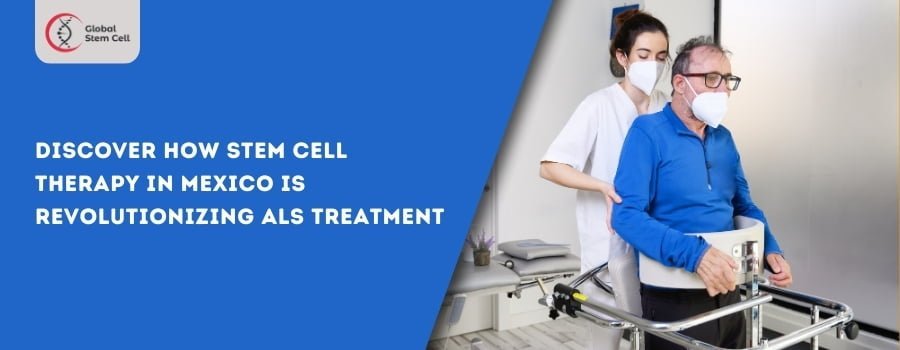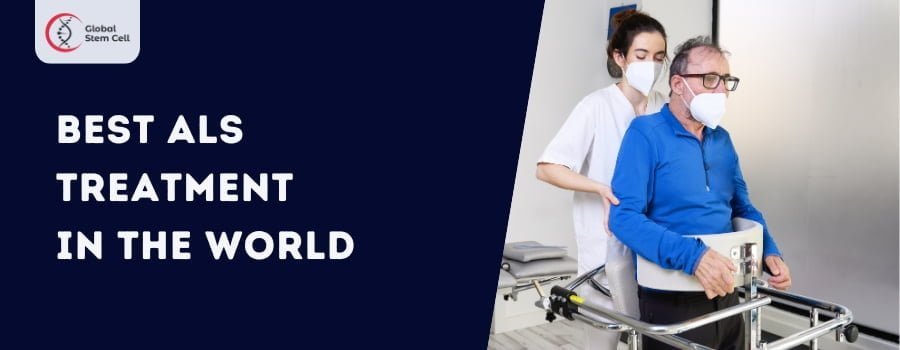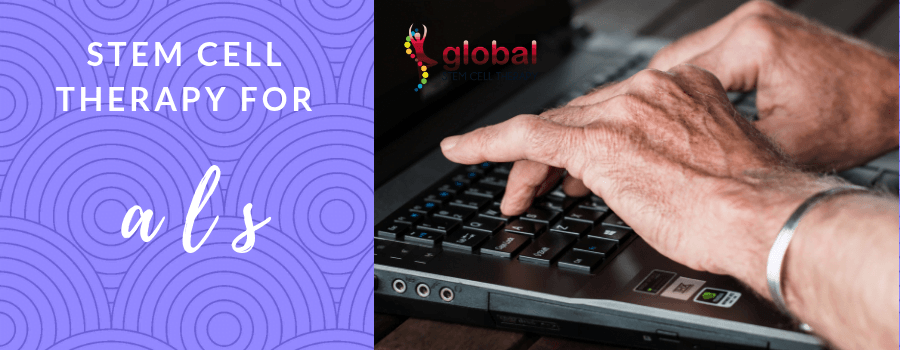
Revolutionizing ALS Treatment – The Impact of Stem Cell Therapy in Mexico
Table of Content
Amyotrophic Lateral Sclerosis (ALS), often referred to as Lou Gehrig’s disease, is a devastating neurodegenerative disorder that progressively robs individuals of their ability to control muscle movements.
As it stands, there is no cure for ALS, and available treatments offer limited relief, primarily focusing on managing symptoms rather than addressing the root cause. However, a promising ray of hope has emerged on the medical horizon in the form of stem cell therapy, with Mexico leading the way in pioneering innovative treatments.
Stem cell therapy represents a groundbreaking approach that harnesses the regenerative potential of stem cells to repair and replace damaged cells in the body. In recent years, Mexico has emerged as a hub for cutting-edge ALS treatments, offering a new frontier of possibilities for patients seeking alternatives to conventional therapies.
In this blog post, we will delve into the current landscape of ALS treatment, explore the transformative power of stem cell therapy, and highlight Mexico’s pivotal role in revolutionizing the approach to managing this debilitating disease.
Understanding ALS and its Challenges
Amyotrophic Lateral Sclerosis (ALS), also known as Lou Gehrig’s disease, is a progressive neurodegenerative disorder that affects nerve cells in the brain and spinal cord. Here are some key aspects to understand about ALS and the challenges associated with it:
Nature of ALS
- Motor Neuron Degeneration: ALS primarily involves the degeneration of motor neurons, which are responsible for controlling voluntary muscles.
- Progressive Nature: The disease is progressive, meaning symptoms worsen over time as more motor neurons are affected.
Symptoms
- Muscle Weakness: Initial symptoms often include muscle weakness, twitching, or stiffness.
- Progressive Paralysis: As the disease advances, individuals may experience difficulty in speaking, swallowing, and breathing.
- Cognitive Function: While ALS primarily affects motor functions, some individuals may also experience changes in cognitive functions.
Challenges Faced by ALS Patients
- Loss of Independence: As muscles weaken, individuals with ALS may face challenges in performing everyday tasks, leading to a loss of independence.
- Communication Difficulties: Communication becomes progressively difficult as speech and muscle control decline. Augmentative and alternative communication (AAC) devices may be used.
- Swallowing and Nutrition: Weakness in the muscles responsible for swallowing can lead to difficulties in eating and drinking, requiring dietary modifications and sometimes a feeding tube.
- Respiratory Issues: Respiratory muscles are affected in ALS, leading to breathing difficulties. Mechanical ventilation support may be required in later stages.
- Emotional and Psychological Impact: Coping with the progressive loss of physical abilities can lead to emotional challenges, including depression and anxiety.
- Financial Burden: The cost of medical care, assistive devices, home modifications, and caregiving can impose a significant financial burden on individuals and their families.
The Promise of Stem Cell Therapy for ALS Treatment
Stem cell therapy holds promise as a potential treatment for Amyotrophic Lateral Sclerosis (ALS), and researchers are exploring various approaches to harness the regenerative potential of stem cells to address the challenges posed by this progressive neurodegenerative disease. Here are key points regarding the potential of stem cell therapy for ALS:
Replacement of Damaged Cells: Stem cells have the ability to differentiate into various cell types, including motor neurons. The hope is that stem cell therapy could replace damaged or degenerated motor neurons in individuals with ALS.
Types of Stem Cells Being Investigated
- Embryonic Stem Cells: These cells have the potential to become any cell type in the body. However, ethical concerns and the risk of tumor formation have limited their widespread use.
- Induced Pluripotent Stem Cells (iPSCs): These are adult cells that have been reprogrammed to have embryonic stem cell-like properties. iPSCs can be derived from a patient’s own cells, reducing the risk of rejection.
- Mesenchymal Stem Cells (MSCs): These cells, derived from sources like bone marrow or adipose tissue, have anti-inflammatory and immunomodulatory properties.
Beyond Cell Replacement: Stem cells may exert therapeutic effects not only through cell replacement but also by secreting trophic factors that promote the survival and health of existing neurons. This paracrine effect could have neuroprotective benefits.
Personalized Medicine: iPSCs offer the possibility of creating patient-specific cell lines, potentially reducing the risk of rejection and improving treatment outcomes.
Stringent Oversight: Stem cell therapies are subject to rigorous regulatory scrutiny due to safety concerns and the need to ensure that interventions are based on sound scientific evidence.
Mexico’s Role in Advancing Stem Cell Therapy
Mexico has made contributions to the field of stem cell research, and there have been efforts to advance stem cell therapy within the country. Here are some aspects highlighting Mexico’s role in advancing stem cell therapy:
Regulatory Environment
- Permissive Regulations: Mexico has been known for having a more permissive regulatory environment compared to some other countries, allowing for a range of medical treatments and therapies, including stem cell interventions.
- Medical Tourism: Due to the regulatory environment, Mexico has attracted individuals seeking stem cell treatments, including those with neurodegenerative conditions like ALS.
Stem Cell Clinics
- Presence of Clinics: Mexico has seen the establishment of various stem cell clinics offering treatments for various conditions, including neurological disorders. These clinics often provide stem cell therapies that may not have undergone rigorous clinical testing.
Collaborative Research Initiatives
- Research Collaborations: Mexican researchers and institutions have engaged in collaborations with international counterparts to advance stem cell research. These collaborations contribute to the global understanding of stem cell biology and potential therapeutic applications.
Scientific Conferences and Events
- Participation in Scientific Community: Mexican researchers and scientists actively participate in international stem cell conferences and events. These forums facilitate the exchange of knowledge and expertise, contributing to advancements in the field.
Real-life stories of ALS patients who have undergone stem cell therapy in Mexico
FAQs about Stem cell Therapy for ALS in Mexico
Here are some frequently asked questions about stem cell therapy for ALS in Mexico:
What types of stem cells are commonly used in ALS treatments in Mexico?
Different clinics may use various types of stem cells, including embryonic stem cells, induced pluripotent stem cells (iPSCs), and mesenchymal stem cells (MSCs). The choice of stem cell type can depend on the clinic’s approach and the specific treatment protocol.
How does stem cell therapy work for ALS in Mexico?
Stem cell therapy for ALS aims to replace or support damaged motor neurons. The mechanism of action may involve the differentiation of stem cells into motor neurons or the release of trophic factors that support the survival of existing neurons. However, the specific protocols can vary between clinics.
What are the risks and potential benefits of stem cell therapy for ALS?
The risks and benefits can vary based on the specific type of stem cells used, the treatment protocol, and individual patient factors. Risks may include infection, immune responses, or unintended differentiation of stem cells. Potential benefits may include neuroprotective effects and the replacement of damaged motor neurons.
What is the cost of stem cell therapy for ALS in Mexico?
The cost can vary widely depending on the clinic, the type of stem cells used, and the treatment protocol. Patients should inquire about all associated costs, including consultations, procedures, and follow-up care.
What follow-up care is recommended after stem cell therapy for ALS?
Comprehensive follow-up care is essential, including regular medical evaluations, monitoring of symptoms, and potential rehabilitation therapies. It’s important to have a clear understanding of the post-treatment care plan.
What are the ethical considerations surrounding stem cell therapy for ALS in Mexico?
Ethical considerations may include the use of certain stem cell types, patient consent, and adherence to regulatory standards. Patients and their families should be well-informed and engage in open discussions with healthcare providers about ethical considerations.
Ready to explore innovative treatment options for ALS? Contact us today to learn more about stem cell therapy in Mexico and take the next step towards improved quality of life.





